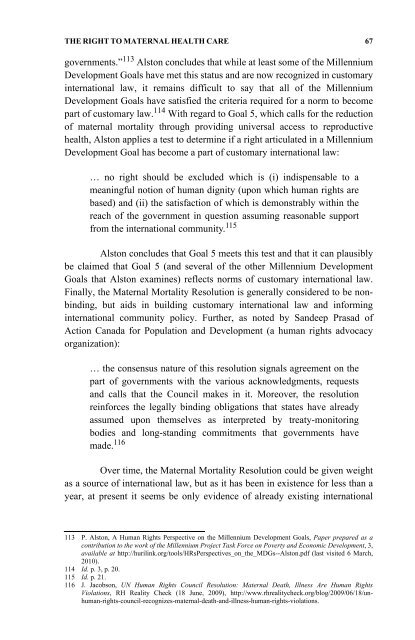University of Botswana Law Journal - PULP
University of Botswana Law Journal - PULP
University of Botswana Law Journal - PULP
You also want an ePaper? Increase the reach of your titles
YUMPU automatically turns print PDFs into web optimized ePapers that Google loves.
THE RIGHT TO MATERNAL HEALTH CARE 67<br />
governments.” 113 Alston concludes that while at least some <strong>of</strong> the Millennium<br />
Development Goals have met this status and are now recognized in customary<br />
international law, it remains difficult to say that all <strong>of</strong> the Millennium<br />
Development Goals have satisfied the criteria required for a norm to become<br />
part <strong>of</strong> customary law. 114 With regard to Goal 5, which calls for the reduction<br />
<strong>of</strong> maternal mortality through providing universal access to reproductive<br />
health, Alston applies a test to determine if a right articulated in a Millennium<br />
Development Goal has become a part <strong>of</strong> customary international law:<br />
… no right should be excluded which is (i) indispensable to a<br />
meaningful notion <strong>of</strong> human dignity (upon which human rights are<br />
based) and (ii) the satisfaction <strong>of</strong> which is demonstrably within the<br />
reach <strong>of</strong> the government in question assuming reasonable support<br />
from the international community. 115<br />
Alston concludes that Goal 5 meets this test and that it can plausibly<br />
be claimed that Goal 5 (and several <strong>of</strong> the other Millennium Development<br />
Goals that Alston examines) reflects norms <strong>of</strong> customary international law.<br />
Finally, the Maternal Mortality Resolution is generally considered to be nonbinding,<br />
but aids in building customary international law and informing<br />
international community policy. Further, as noted by Sandeep Prasad <strong>of</strong><br />
Action Canada for Population and Development (a human rights advocacy<br />
organization):<br />
… the consensus nature <strong>of</strong> this resolution signals agreement on the<br />
part <strong>of</strong> governments with the various acknowledgments, requests<br />
and calls that the Council makes in it. Moreover, the resolution<br />
reinforces the legally binding obligations that states have already<br />
assumed upon themselves as interpreted by treaty-monitoring<br />
bodies and long-standing commitments that governments have<br />
made. 116<br />
Over time, the Maternal Mortality Resolution could be given weight<br />
as a source <strong>of</strong> international law, but as it has been in existence for less than a<br />
year, at present it seems be only evidence <strong>of</strong> already existing international<br />
113 P. Alston, A Human Rights Perspective on the Millennium Development Goals, Paper prepared as a<br />
contribution to the work <strong>of</strong> the Millennium Project Task Force on Poverty and Economic Development, 3,<br />
available at http://hurilink.org/tools/HRsPerspectives_on_the_MDGs--Alston.pdf (last visited 6 March,<br />
2010).<br />
114 Id. p. 3, p. 20.<br />
115 Id. p. 21.<br />
116 J. Jacobson, UN Human Rights Council Resolution: Maternal Death, Illness Are Human Rights<br />
Violations, RH Reality Check (18 June, 2009), http://www.rhrealitycheck.org/blog/2009/06/18/unhuman-rights-council-recognizes-maternal-death-and-illness-human-rights-violations.
















